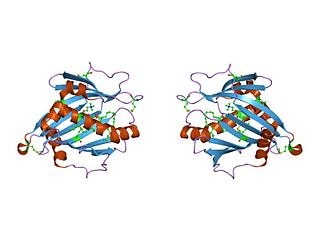
ATP-binding cassette sub-family A member 12 also known as ATP-binding cassette transporter 12 is a protein that in humans is encoded by the ABCA12 gene.

High affinity cationic amino acid transporter 1 is a protein that in humans is encoded by the SLC7A1 gene.

Large neutral amino acids transporter small subunit 2 is a protein that in humans is encoded by the SLC7A8 gene.

StAR-related lipid transfer protein 5 is a protein that in humans is encoded by the STARD5 gene. The protein is a 213 amino acids long, consisting almost entirely of a StAR-related transfer (START) domain. It is also part of the StarD4 subfamily of START domain proteins, sharing 34% sequence identity with STARD4.

The mitochondrial dicarboxylate carrier (DIC) is an integral membrane protein encoded by the SLC25A10 gene in humans that catalyzes the transport of dicarboxylates such as malonate, malate, and succinate across the inner mitochondrial membrane in exchange for phosphate, sulfate, and thiosulfate by a simultaneous antiport mechanism, thus supplying substrates for the Krebs cycle, gluconeogenesis, urea synthesis, fatty acid synthesis, and sulfur metabolism.

D-beta-hydroxybutyrate dehydrogenase, mitochondrial is an enzyme that in humans is encoded by the BDH1 gene.

Cationic amino acid transporter 3 is a protein that in humans is encoded by the SLC7A3 gene.

Vesicular inhibitory amino acid transporter is a protein that in humans is encoded by the SLC32A1 gene.

Cationic amino acid transporter 2 is a protein that in humans is encoded by the SLC7A2 gene.

Cationic amino acid transporter 4 is a protein that in humans is encoded by the SLC7A4 gene.

StAR-related lipid transfer protein 10 (STARD10) or PCTP-like protein is a lipid transfer protein that in humans is encoded by the STARD10 gene. The protein derives its name from the fact that the molecule contains a START domain. As part of the StarD2 subfamily, StarD10 can transport the lipids phosphatidylcholine and phosphatidylethanolamine between membranes in solution. Casein kinase II phosphorylates the protein on its serine at position 184.

Y+L amino acid transporter 2, also known as cationic amino acid transporter, y+ system, is a protein that in humans is encoded by the SLC7A6 gene.

Phosphatidylcholine transfer protein (PCTP) also known as StAR-related lipid transfer domain protein 2 (STARD2) is a specific intracellular phospholipid binding protein that can transfer phosphatidylcholine between different membranes in the cytosol.

StAR-related lipid transfer protein 4 (STARD4) is a soluble protein involved in cholesterol transport. It can transfer up to 7 sterol molecules per minute between artificial membranes.
Coiled-coil domain containing 109B (CCDC109B) is a potential calcium uniporter protein found in the membrane of human cells and is encoded by the CCDC109B gene. While CCDC109B is a transmembrane protein it is unclear if it is located within the cell membrane or mitochondrial membrane.

Collagen α-1 (XXIII) chain is a protein encoded by COL23A1 gene, which is located on chromosome 5q35 in humans, and on chromosome 11B1+2 in mice. The location of this gene was discovered by genomic sequence analysis.

Histidine triad nucleotide binding protein 2 (HINT2) is a mitochondrial protein that in humans is encoded by the HINT2 gene on chromosome 9. This protein is an AMP-lysine hydrolase and phosphoamidase and may contribute to tumor suppression.

Zinc transporter ZIP9, also known as Zrt- and Irt-like protein 9 (ZIP9) and solute carrier family 39 member 9, is a protein that in humans is encoded by the SLC39A9 gene. This protein is the 9th member out of 14 ZIP family proteins, which is a membrane androgen receptor (mAR) coupled to G proteins, and also classified as a zinc transporter protein. ZIP family proteins transport zinc metal from the extracellular environment into cells through cell membrane.

Solute carrier family 38 member 5 is a protein that in humans is encoded by the SLC38A5 gene.

StAR related lipid transfer domain containing 3(STARD3) is a protein that in humans is encoded by the STARD3 gene. STARD3 also known as metastatic lymph node 64 protein (MLN64) is a late endosomal integral membrane protein involved in cholesterol transport. STARD3 creates membrane contact sites between the endoplasmic reticulum (ER) and late endosomes where it moves cholesterol.


















